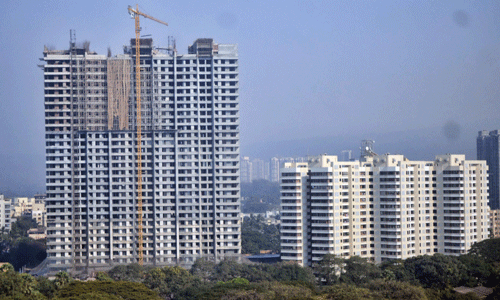 Track2Realty Exclusive: Samarjeet Singh went on a house hunt in Mumbai with the obvious expectations of entering into a buyers’ market. The reported stress and standing inventory of 48 months made him believe that this is the right time to negotiate the deal and also get the immediate possession with a record inventory available in the market. However, the reported figure of 48 months of inventory ready in Mumbai was juxtaposed to the ground realities in the city, as this automobile professional found. With hardly any ready-to-move apartment available in most of the micro markets that he was searching property, he realised that under-construction projects are what is being projected as standing inventory in the market.
Track2Realty Exclusive: Samarjeet Singh went on a house hunt in Mumbai with the obvious expectations of entering into a buyers’ market. The reported stress and standing inventory of 48 months made him believe that this is the right time to negotiate the deal and also get the immediate possession with a record inventory available in the market. However, the reported figure of 48 months of inventory ready in Mumbai was juxtaposed to the ground realities in the city, as this automobile professional found. With hardly any ready-to-move apartment available in most of the micro markets that he was searching property, he realised that under-construction projects are what is being projected as standing inventory in the market.
“Forget the best negotiations borne out of developers’ stress, as I thought, the fact of the matter is that in terms of demand and supply scenario I have realised that there is always less supply than the demand. Most of the reports suggesting inventory ready and discounts on offer are just there in the media reports. What I am apprehensive now is that if I don’t buy the property now with the reported expectations of price correction, I may end up paying more soon,” says Samarjeet.
Samarjeet’s first hand account of property search in the Mumbai market actually reflects the ground reality of Mumbai where analysts maintain the city property is still so much in demand that momentary ups & downs in the transaction cycle will not dent the sheen out of this market.
Harjith Bubber, CEO and Managing Director, CCI Projects categorically says that not many ready-to-move properties are available. Most of the projects are still under-construction. It is an advantage for users when ready flats are available for purchase as there is certainty as to when they can move into their new home. However, for investors it is better to opt for projects that are underway as they can get the same property at a lower cost and benefit by its appreciation in the longer run.
“Less launches may actually lead to supply constraint in the next cycle of delivery in 3-5 years. As per the market dynamics of the demand-supply cycle it is most likely that we will see a shortfall of supply in five years from now as developers are focusing on delivering their ongoing projects before launching new ones. With numerous big and small developers in Mumbai, there is a constant battle for attracting the consumer’s attention. Therefore, with the plethora of choices available in the real estate arena, Mumbai is definitely a buyers’ market,” says Bubber.
Anshuman Magazine, CMD of CBRE South Asia, on the contrary, says it is a buyer’s market at present. With the large quantum of ready-to-move in properties, buyers now have the advantage of assessing investment grade property; and making their investment decisions accordingly. The apprehension associated with on-time delivery and the quality of construction is also mitigated in such a scenario. However, buyers are always advised to exercise due diligence on any property they may be interested in.
“Developers with large land parcels plan to launch new buildings within their existing projects in a phased manner. By the next delivery cycle, therefore, there will be enough fresh supply in place. Buyers do have an advantage in the current market scenario, as some developers have been offering price discounts, while others have been offering promotional schemes, such as free stamp duty and registration, international tours, modular kitchens, and so on. It all stems from the current demand slowdown brought on by rising inflationary conditions, and buyers’ perception of unsustainable property prices,” says Magazine.
Santosh Naik, MD & CEO of Disha Direct says the actual users are buying ready property as they want to shift immediately. Also this reduces risk of late deliveries of projects where they loose on interests on their home loans. But buyers are buying only where they are getting value for their money.
“I don’t think less launches lead to supply constraint in the next cycle of delivery because once the market improves all developers will launch new projects and if they are able to sell good numbers they will deliver the projects with new technologies. The supply constraints will be in locations where these is scarcity of land. There will be always demand supply gap in these areas,” says Naik.
Analysts maintain Mumbai is increasingly turning out to be a buyers’ market not due to standing inventory but since various price restructuring is being done by the developers to lure buyers. This is a cyclic process in real industry rather in any industry in last few decades. Where there is more supply than the demand it is the buyers’ market, and once the supply is less than the demand its sellers’ market. However, there is no imbalance in demand-supply cycle to conclude that Mumbai is a buyers’ market due to developers’ financial stress or standing inventory.
The property buyers in Mumbai, on the look-out for standing inventory, are rather questioning where ready-to-move apartment that can be bought is. Developers too have no answer to this and all that they have to offer is under-construction project. The reports of standing inventory have, on its part, not made a differentiation between ready-to-move inventory and under-construction projects. The financial analysts believe the basic fundamentals of economics suggest that the product in the pipeline is not the inventory; rather it is the finished product which can be termed as inventory. That is not a case with the analysis of Mumbai real estate and its inventory. But then the real estate has historically been analysed and dissected by defying the conventional wisdom of demand & supply dynamics of economics, something that neither helps the developers nor the buyers.





